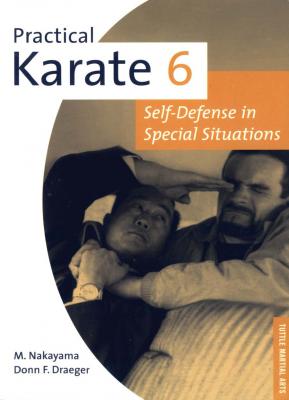Practical Karate Volume 6. Donn F. Draeger
Читать онлайн.| Название | Practical Karate Volume 6 |
|---|---|
| Автор произведения | Donn F. Draeger |
| Жанр | Спорт, фитнес |
| Серия | |
| Издательство | Спорт, фитнес |
| Год выпуска | 0 |
| isbn | 9781462905140 |
Disclaimer
The adoption and application of the material offered in this book is at the reader's discretion and sole responsibility. The Author and Publisher of this book are not responsible in any manner whatsoever for any injury that may occur indirectly or directly from the use of this book. Since the physical activities described herein may be too strenuous in nature for some readers to engage in safely, please consult a physician prior to training. The specific self-defense practices illustrated in this book may not be justified in every particular situation or under applicable federal, state or local law. Neither the Author or the Publisher make any warranty or representation regarding the legality or appropriateness of any technique mentioned in this book.
Copyright 1966 by Charles E. Tuttle Co., Inc. with editorial offices at 364 Innovation Drive, North Clarendon, VT 05759 U.S.A.
Copyright © renewed 1994 by Charles E. Tuttle Co., Inc.
All rights reserved. No part of this publication may be reproduced or utilized in any form or by any means, electronic or mechanical, including photocopying, recording, or by any information storage and retrieval system, without prior written permission from Tuttle Publishing.
Library of Congress Catalog Card Number: 98-87646
ISBN: 978-1-4629-0514-0 (ebook)
DISTRIBUTED BY
| NORTH AMERICA | SOUTHEAST ASIA | JAPAN |
| Tuttle Publishing USA | Berkeley Books Pte. Ltd. | Tuttle Publishing Japan |
| 364 Innovation Drive | 61 Tai Seng Avenue, #02-12 | Yaekari Building 3rd Floor, 5-4-12 |
| North Clarendon, VT 05759-9436 | Singapore 534167 | Osaki Shinagawa-ku, |
| Tel: (802) 773-8930 | Tel: (65) 6280-1330 | Tokyo 141-0032 |
| Tel: (800) 773 6993 | Fax: (65) 6280-6290 | Tel: 81 (03) 5437 0171 |
| Fax 81 (03) 5437 0755 |
First edition
07 06 05 04 03 02 01 00 99 98 10 9 8 7 6 5 4 3 2 1
Printed in Singapore
TABLE OF CONTENTS
| Authors' Foreword | 7 | |
| Preface | 11 | |
| Essential Points | 14 | |
| Chapter One: AUTOMOBILE SITUATIONS | 15 | |
| Rear Seat Bare-handed Choke; Rear Seat Judo Arm Choke; Rear Seat Judo Lapel Choke; Rear Seat Garrotte; Rear Seat Double Assailant Threat; Single Assailant Outside Threat; Double Assailant Outside Threat | ||
| Chapter Two: TIED HAND SITUATIONS | 55 | |
| Frontal Tie—Single Assailant, Single Punch; Frontal Tie—Single Assailant, Kicking Attack; Frontal Tie—Single Assailant, Kick and Double Punch Attack; Frontal Tie—Single Assailant, Hold and Punch Attack; Rear Tie— Single Assailant, Grasp and Punch; Rear Tie —Double Assailant, Rough-up | ||
| Chapter Three: SWITCHBLADE, CHAIN, MEATCLEAVER AND RAZOR ATTACKS | 91 | |
| Frontal Free Threat—Switchblade; Frontal Free Threat—Chain; Frontal Free Threat— Meatcleaver; Frontal Free Threat—Razor | ||
| Chapter Four: HANDGUN ATTACKS | 113 | |
| Frontal Free Threat; Frontal Search; Rear Free Threat |
AUTHORS' FOREWORD
THERE is perhaps no greater disservice to man than the creation of false confidence in his ability to defend himself. Whether this false confidence is manifested in his nation's armed might, or his own personal ability, the result is the same, though of different proportions, when tested—disaster!
The current karate boom in the U.S.A. has instilled in many would-be experts a serious, false sense of security. This is the natural outgrowth of a human psychological weakness. Everyone wishes to be physically fit and able to defend himself and his loved ones from danger and quickly turns to any sure-fire guarantee of such abilities.
Unscrupulous and unqualified self-appointed karate "experts" daily exploit this human weakness and prey on an innocent, unsuspecting public. This grossly perpetrated fraud is based on the quick learning of ancient mysterious Oriental combative forms such as karate, and almost always makes its appeal colorful through the use of adjectives such as "super," "destructive," "terror tactics," and guarantees you mastery of an art that will make you "fear no man." All such get-skillful-quickly schemes should be carefully investigated before taking them seriously, for true karate involves constant dedication to training and is never a short-course method. Choose your instructor carefully.
On the other hand, authentic teachers of karate do exist in the U.S.A., and their teachings have full merit. These teachings are deeply rooted in traditional, classical karate and require a liberal application of patience and regular training to develop expert karate skill. There are various schools that stem from historic Oriental antiquity, all of which are legitimate and have both merits and shortcomings. The choice of which school to follow can be decided upon only by the interested party.
The average person is confined to a daily life that requires of him a heavy investment in time and energy in order to earn a living. Leisure time is generally at a minimum and it is spent at less enervating pursuits than classical karate practice, a demanding and rigorous "pastime." But the need for a practical system of self-defense designed for the average person is more evident than ever before. Police files give mute testimony to the increasing number of robberies, assaults, and other vicious crimes.
In self-defense situations involving assailants armed with extremely dangerous weapons or those situations which are unusual due to circumstances of one's physical location or because of the nature of the method the assailant or assailants are using, each situation involves and carries with it a degree of danger beyond normal attack circumstances. Accordingly, karate techniques must be learned thoroughly and executed as automatic responses to any series of happenings if serious injury or death is to be avoided.
Like its predecessors—Books One, Two, Three, and Four—this book is a categorized collection of self-defense situations and recommended
